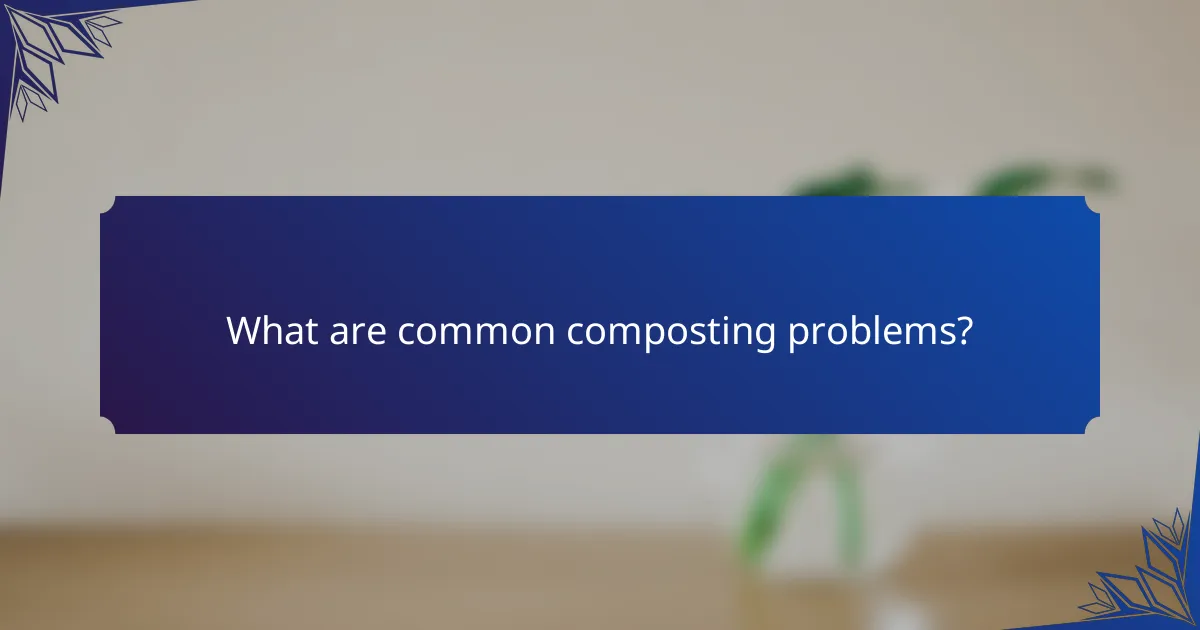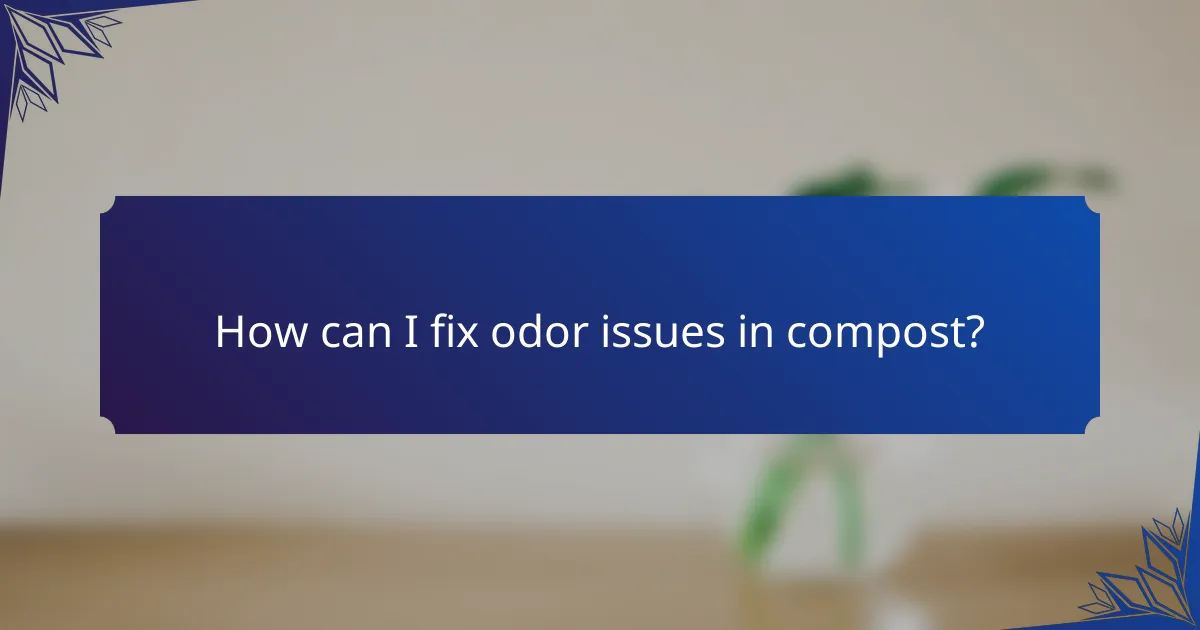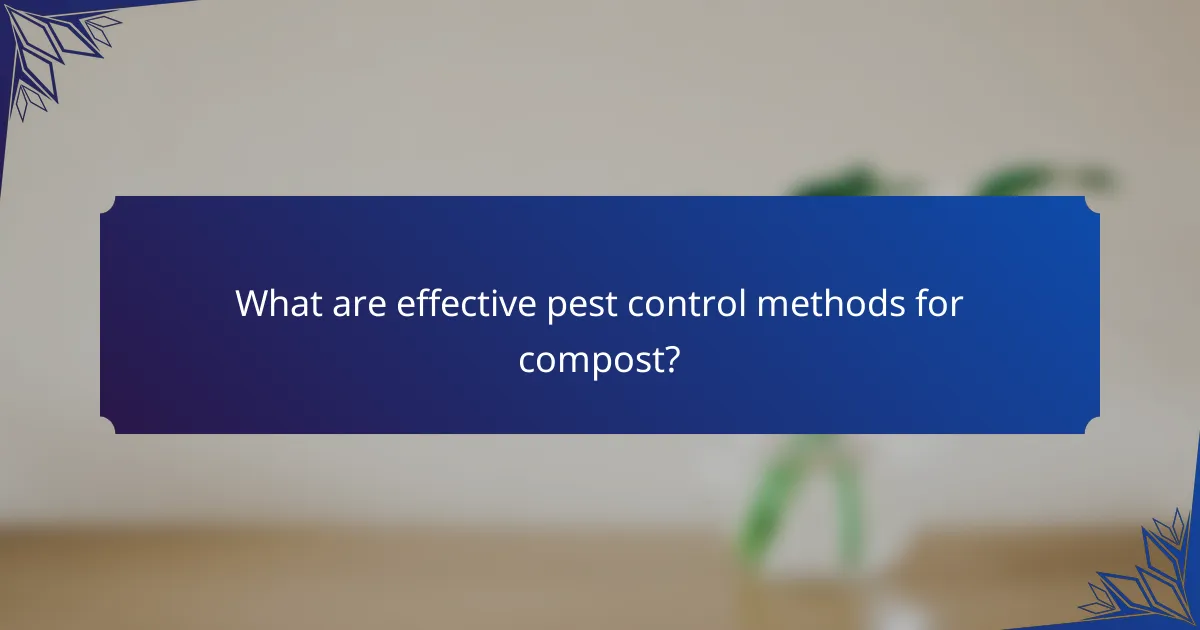Composting can sometimes present challenges such as odor issues, excess moisture, slow decomposition, pest infestations, and insufficient heat. By identifying the root causes of these problems and implementing effective solutions, you can enhance the composting process and achieve better results. Understanding the balance of materials and maintaining proper aeration are key to overcoming these common obstacles.

What are common composting problems?
Common composting problems include odor issues, excess moisture, slow decomposition, pest infestations, and insufficient heat. Addressing these challenges effectively can lead to a healthier composting process and better results.
Odor issues
Odor issues in composting often arise from an imbalance of materials. A strong, unpleasant smell typically indicates too much nitrogen-rich material, such as food scraps, or insufficient aeration.
To mitigate odors, ensure a balanced mix of green (nitrogen-rich) and brown (carbon-rich) materials. Regularly turning the compost pile can also improve airflow and reduce smells.
Excess moisture
Excess moisture can lead to a soggy compost pile, which slows down decomposition and creates a foul odor. This often occurs when too many wet materials, like fruit peels or grass clippings, are added without sufficient dry materials.
To manage moisture levels, aim for a compost pile that feels like a damp sponge. If the pile is too wet, incorporate dry materials such as straw or shredded paper to absorb excess moisture.
Slow decomposition
Slow decomposition can result from inadequate aeration, improper material balance, or insufficient heat. If the compost pile is not breaking down as expected, it may need more turning or a better mix of greens and browns.
To speed up the process, ensure the pile is at least 3 feet in size to retain heat and moisture. Adding compost activators, such as aged manure or commercial starters, can also help accelerate decomposition.
Pest infestations
Pest infestations, including rodents and insects, can occur when compost piles attract unwanted animals or are improperly managed. This is often due to adding meat, dairy, or oily foods that emit strong odors.
To prevent pests, avoid adding these types of materials and cover the compost pile with a lid or tarp. Regularly turning the pile can also deter pests by disrupting their habitat.
Insufficient heat
Insufficient heat in a compost pile can slow down the decomposition process and lead to a less effective compost. This often happens when the pile is too small or lacks the right balance of materials.
To generate adequate heat, ensure the compost pile is at least 3 feet high and includes a mix of greens and browns. Turning the pile regularly can help maintain temperature and promote faster breakdown of materials.

How can I fix odor issues in compost?
To fix odor issues in compost, it’s essential to identify the underlying causes, which often stem from an imbalance in materials or insufficient aeration. By adjusting the carbon-to-nitrogen ratio, improving aeration, and turning the compost regularly, you can significantly reduce unpleasant smells.
Adjust carbon-to-nitrogen ratio
The carbon-to-nitrogen (C:N) ratio is crucial for effective composting. A balanced ratio, typically around 30:1, helps microorganisms break down organic matter efficiently. If your compost is too high in nitrogen (like fresh grass clippings), it can produce ammonia odors.
To adjust the C:N ratio, add more carbon-rich materials such as dried leaves, straw, or shredded paper. Aim for a mix that includes both green (nitrogen-rich) and brown (carbon-rich) materials to create a balanced environment for decomposition.
Improve aeration
Aeration is vital for preventing anaerobic conditions that lead to foul odors. Compost should have adequate airflow to support aerobic bacteria, which break down materials without producing unpleasant smells. If your compost pile is compacted, it may restrict airflow.
To improve aeration, consider turning the pile or using a compost aerator tool. Adding coarse materials like wood chips can also help create air pockets, enhancing airflow throughout the compost.
Turn the compost regularly
Regularly turning your compost helps mix materials and introduces oxygen, which is essential for aerobic decomposition. Aim to turn the pile every few weeks, depending on its size and moisture level. This practice not only reduces odors but also speeds up the composting process.
When turning, check for moisture levels; the compost should feel damp but not soggy. If it’s too dry, add water; if it’s too wet, incorporate more dry materials. Keeping the right moisture balance is key to maintaining a healthy compost environment.

What causes excess moisture in compost?
Excess moisture in compost can result from various factors, primarily environmental conditions and material composition. Understanding these causes helps in managing moisture levels effectively for optimal composting.
Heavy rainfall
Heavy rainfall can significantly increase the moisture content in compost piles, especially if they are not adequately covered. When rainwater saturates the compost, it can lead to anaerobic conditions, which hinder decomposition and create unpleasant odors.
To mitigate this issue, consider placing a tarp over your compost pile during periods of heavy rain. Alternatively, building your compost bin with a roof or using a covered container can help protect it from excess water.
High nitrogen content
A compost pile with high nitrogen content can retain more moisture than balanced mixtures. Nitrogen-rich materials, such as grass clippings and food scraps, can create a wet environment that may lead to clumping and poor aeration.
To balance moisture levels, mix high-nitrogen materials with dry, carbon-rich materials like leaves or straw. Aim for a carbon-to-nitrogen ratio of about 30:1 to maintain optimal moisture and aeration.
Poor drainage
Poor drainage can trap water in a compost pile, leading to excess moisture accumulation. If your compost bin is placed in a low-lying area or on a surface that does not allow for water runoff, it can become waterlogged.
To improve drainage, elevate your compost bin on a platform or use a bin design that allows for airflow and water escape. Regularly turning the compost can also help aerate the pile and reduce moisture retention.

How can I speed up decomposition in my compost?
To speed up decomposition in your compost, focus on optimizing conditions that promote microbial activity. Key factors include aeration, material size, and the addition of compost activators.
Increase aeration
Aeration is crucial for speeding up the composting process as it provides oxygen to the microorganisms that break down organic matter. Turning your compost pile regularly, ideally every few weeks, enhances airflow and promotes faster decomposition.
Consider using a compost aerator tool or simply turning the pile with a pitchfork to mix materials. Aim for a balance between wet and dry materials to maintain adequate moisture without creating anaerobic conditions.
Chop materials into smaller pieces
Chopping or shredding compost materials into smaller pieces increases the surface area available for microbes, leading to quicker breakdown. Aim for pieces no larger than a few inches to maximize efficiency.
For example, cut up kitchen scraps and yard waste before adding them to the compost pile. This practice not only speeds up decomposition but also helps maintain a more uniform texture in the compost.
Add compost activators
Compost activators, such as green materials rich in nitrogen (like grass clippings or food scraps), can significantly enhance microbial activity. Adding these materials can help jumpstart the decomposition process, especially if your compost is slow to break down.
Consider using commercial compost starters or natural options like manure or worm castings. A good rule of thumb is to maintain a carbon-to-nitrogen ratio of about 30:1 for optimal results.

What are effective pest control methods for compost?
Effective pest control methods for compost include covering compost bins and avoiding the addition of meat and dairy products. These strategies help deter pests such as rodents and insects, ensuring a healthier composting process.
Cover compost bins
Covering compost bins is a straightforward method to prevent pests from accessing the compost. A well-fitted lid or tarp can keep out rodents, raccoons, and other animals that might be attracted to the organic material.
Ensure that the cover allows for proper aeration while still providing sufficient protection. Using bins with tight-fitting lids or mesh covers can strike a balance between ventilation and pest prevention.
Avoid adding meat and dairy
Meat and dairy products are highly attractive to pests and should be excluded from compost. These items can produce strong odors that lure animals, making your compost a target for scavengers.
Stick to plant-based materials like fruit and vegetable scraps, coffee grounds, and yard waste. This not only minimizes pest attraction but also helps maintain a balanced compost that decomposes effectively.
